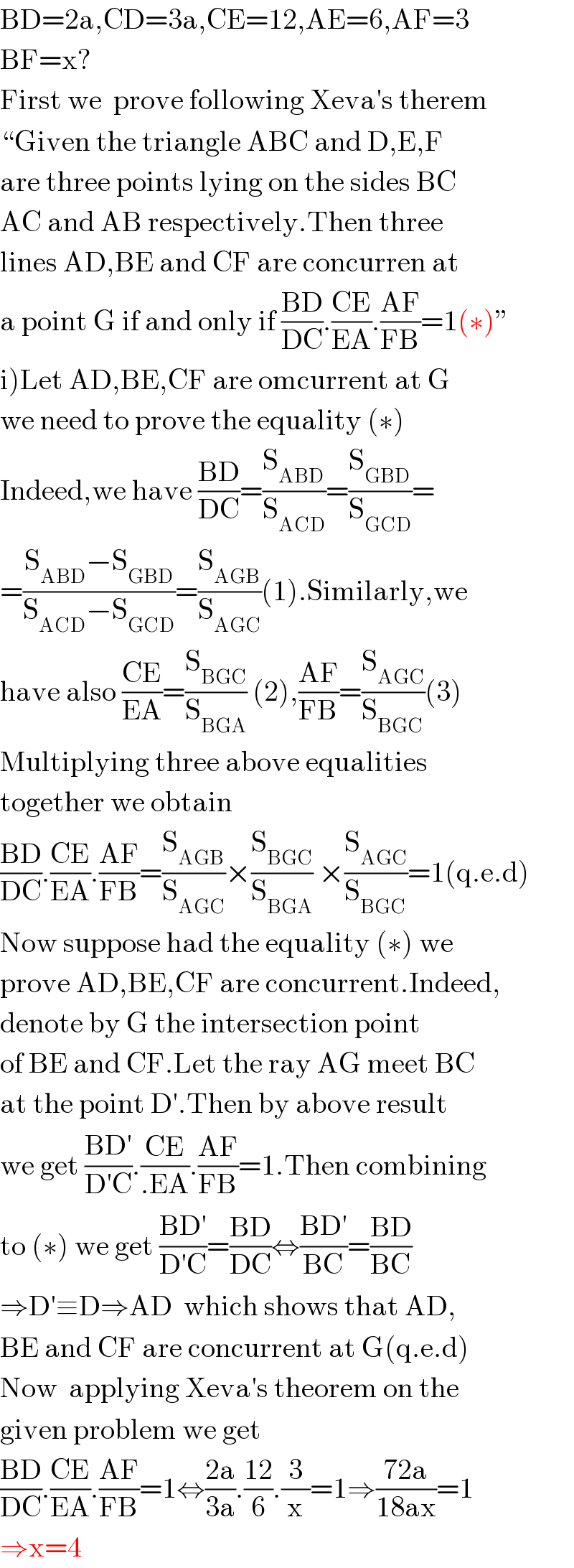Question Number 108067 by I want to learn more last updated on 14/Aug/20

Answered by 1549442205PVT last updated on 14/Aug/20

Commented by 1549442205PVT last updated on 14/Aug/20

$$\mathrm{BD}=\mathrm{2a},\mathrm{CD}=\mathrm{3a},\mathrm{CE}=\mathrm{12},\mathrm{AE}=\mathrm{6},\mathrm{AF}=\mathrm{3} \\ $$$$\mathrm{BF}=\mathrm{x}? \\ $$$$\mathrm{First}\:\mathrm{we}\:\:\mathrm{prove}\:\mathrm{following}\:\mathrm{Xeva}'\mathrm{s}\:\mathrm{therem} \\ $$$$“\mathrm{Given}\:\mathrm{the}\:\mathrm{triangle}\:\mathrm{ABC}\:\mathrm{and}\:\mathrm{D},\mathrm{E},\mathrm{F} \\ $$$$\mathrm{are}\:\mathrm{three}\:\mathrm{points}\:\mathrm{lying}\:\mathrm{on}\:\mathrm{the}\:\mathrm{sides}\:\mathrm{BC} \\ $$$$\mathrm{AC}\:\mathrm{and}\:\mathrm{AB}\:\mathrm{respectively}.\mathrm{Then}\:\mathrm{three} \\ $$$$\mathrm{lines}\:\mathrm{AD},\mathrm{BE}\:\mathrm{and}\:\mathrm{CF}\:\mathrm{are}\:\mathrm{concurren}\:\mathrm{at} \\ $$$$\mathrm{a}\:\mathrm{point}\:\mathrm{G}\:\mathrm{if}\:\mathrm{and}\:\mathrm{only}\:\mathrm{if}\:\frac{\mathrm{BD}}{\mathrm{DC}}.\frac{\mathrm{CE}}{\mathrm{EA}}.\frac{\mathrm{AF}}{\mathrm{FB}}=\mathrm{1}\left(\ast\right)'' \\ $$$$\left.\mathrm{i}\right)\mathrm{Let}\:\mathrm{AD},\mathrm{BE},\mathrm{CF}\:\mathrm{are}\:\mathrm{omcurrent}\:\mathrm{at}\:\mathrm{G} \\ $$$$\mathrm{we}\:\mathrm{need}\:\mathrm{to}\:\mathrm{prove}\:\mathrm{the}\:\mathrm{equality}\:\left(\ast\right) \\ $$$$\mathrm{Indeed},\mathrm{we}\:\mathrm{have}\:\frac{\mathrm{BD}}{\mathrm{DC}}=\frac{\mathrm{S}_{\mathrm{ABD}} }{\mathrm{S}_{\mathrm{ACD}} }=\frac{\mathrm{S}_{\mathrm{GBD}} }{\mathrm{S}_{\mathrm{GCD}} }= \\ $$$$=\frac{\mathrm{S}_{\mathrm{ABD}} −\mathrm{S}_{\mathrm{GBD}} }{\mathrm{S}_{\mathrm{ACD}} −\mathrm{S}_{\mathrm{GCD}} }=\frac{\mathrm{S}_{\mathrm{AGB}} }{\mathrm{S}_{\mathrm{AGC}} }\left(\mathrm{1}\right).\mathrm{Similarly},\mathrm{we} \\ $$$$\mathrm{have}\:\mathrm{also}\:\frac{\mathrm{CE}}{\mathrm{EA}}=\frac{\mathrm{S}_{\mathrm{BGC}} }{\mathrm{S}_{\mathrm{BGA}} }\:\left(\mathrm{2}\right),\frac{\mathrm{AF}}{\mathrm{FB}}=\frac{\mathrm{S}_{\mathrm{AGC}} }{\mathrm{S}_{\mathrm{BGC}} }\left(\mathrm{3}\right) \\ $$$$\mathrm{Multiplying}\:\mathrm{three}\:\mathrm{above}\:\mathrm{equalities}\: \\ $$$$\mathrm{together}\:\mathrm{we}\:\mathrm{obtain} \\ $$$$\frac{\mathrm{BD}}{\mathrm{DC}}.\frac{\mathrm{CE}}{\mathrm{EA}}.\frac{\mathrm{AF}}{\mathrm{FB}}=\frac{\mathrm{S}_{\mathrm{AGB}} }{\mathrm{S}_{\mathrm{AGC}} }×\frac{\mathrm{S}_{\mathrm{BGC}} }{\mathrm{S}_{\mathrm{BGA}} }\:×\frac{\mathrm{S}_{\mathrm{AGC}} }{\mathrm{S}_{\mathrm{BGC}} }=\mathrm{1}\left(\mathrm{q}.\mathrm{e}.\mathrm{d}\right) \\ $$$$\mathrm{Now}\:\mathrm{suppose}\:\mathrm{had}\:\mathrm{the}\:\mathrm{equality}\:\left(\ast\right)\:\mathrm{we} \\ $$$$\mathrm{prove}\:\mathrm{AD},\mathrm{BE},\mathrm{CF}\:\mathrm{are}\:\mathrm{concurrent}.\mathrm{Indeed}, \\ $$$$\mathrm{denote}\:\mathrm{by}\:\mathrm{G}\:\mathrm{the}\:\mathrm{intersection}\:\mathrm{point} \\ $$$$\mathrm{of}\:\mathrm{BE}\:\mathrm{and}\:\mathrm{CF}.\mathrm{Let}\:\mathrm{the}\:\mathrm{ray}\:\mathrm{AG}\:\mathrm{meet}\:\mathrm{BC} \\ $$$$\mathrm{at}\:\mathrm{the}\:\mathrm{point}\:\mathrm{D}'.\mathrm{Then}\:\mathrm{by}\:\mathrm{above}\:\mathrm{result} \\ $$$$\mathrm{we}\:\mathrm{get}\:\frac{\mathrm{BD}'}{\mathrm{D}'\mathrm{C}}.\frac{\mathrm{CE}}{.\mathrm{EA}}.\frac{\mathrm{AF}}{\mathrm{FB}}=\mathrm{1}.\mathrm{Then}\:\mathrm{combining} \\ $$$$\mathrm{to}\:\left(\ast\right)\:\mathrm{we}\:\mathrm{get}\:\frac{\mathrm{BD}'}{\mathrm{D}'\mathrm{C}}=\frac{\mathrm{BD}}{\mathrm{DC}}\Leftrightarrow\frac{\mathrm{BD}'}{\mathrm{BC}}=\frac{\mathrm{BD}}{\mathrm{BC}} \\ $$$$\Rightarrow\mathrm{D}'\equiv\mathrm{D}\Rightarrow\mathrm{AD}\:\:\mathrm{which}\:\mathrm{shows}\:\mathrm{that}\:\mathrm{AD}, \\ $$$$\mathrm{BE}\:\mathrm{and}\:\mathrm{CF}\:\mathrm{are}\:\mathrm{concurrent}\:\mathrm{at}\:\mathrm{G}\left(\mathrm{q}.\mathrm{e}.\mathrm{d}\right) \\ $$$$\mathrm{Now}\:\:\mathrm{applying}\:\mathrm{Xeva}'\mathrm{s}\:\mathrm{theorem}\:\mathrm{on}\:\mathrm{the} \\ $$$$\mathrm{given}\:\mathrm{problem}\:\mathrm{we}\:\mathrm{get} \\ $$$$\frac{\mathrm{BD}}{\mathrm{DC}}.\frac{\mathrm{CE}}{\mathrm{EA}}.\frac{\mathrm{AF}}{\mathrm{FB}}=\mathrm{1}\Leftrightarrow\frac{\mathrm{2a}}{\mathrm{3a}}.\frac{\mathrm{12}}{\mathrm{6}}.\frac{\mathrm{3}}{\mathrm{x}}=\mathrm{1}\Rightarrow\frac{\mathrm{72a}}{\mathrm{18ax}}=\mathrm{1} \\ $$$$\Rightarrow\mathrm{x}=\mathrm{4} \\ $$
Commented by I want to learn more last updated on 14/Aug/20

$$\mathrm{I}\:\mathrm{really}\:\mathrm{appreciate}\:\mathrm{sir} \\ $$
Answered by floor(10²Eta[1]) last updated on 14/Aug/20

$$\mathrm{by}\:\mathrm{ceva}'\mathrm{s}\:\mathrm{theorem}: \\ $$$$\frac{\mathrm{2a}}{\mathrm{3a}}×\frac{\mathrm{12}}{\mathrm{6}}×\frac{\mathrm{3}}{\mathrm{x}}=\mathrm{1}\Rightarrow\mathrm{x}=\mathrm{4} \\ $$
Commented by I want to learn more last updated on 14/Aug/20

$$\mathrm{I}\:\mathrm{really}\:\mathrm{appreciate}\:\mathrm{sir} \\ $$
